Flowing water in rivers, creeks, waterfalls and still water bodies such as ponds or lakes have become some of my favorite photography subjects. In this article we will discuss techniques when photographing water and how to create silky water effects and brilliant water reflections.
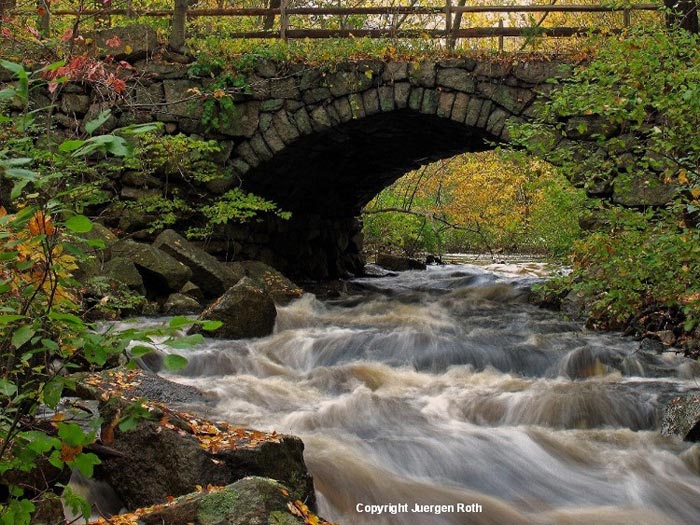
Part I: Silky Water Effects
Moving water photos provide a viewer with a feel for the river’s flow, energy and texture. And, achieving the soft, silky effect can prove difficult, but with some practice, you will temper the movement of the water and make beautiful images.
Sudbury River above was one of my first of this kind. I discovered the scene by chance on a car trip during the end of the peak fall foliage in New England. While driving in route to one of my daughter’s soccer games, I caught a glimpse of the cobble stone bridge over the Sudbury River and committed the image to memory.
The next day was cloudy, providing one of the ideal conditions when photographing flowing water scenes, so I decided to go back and work the location (sunrise and twilight are also ideal). The whites of the water’s froth, bubbles and foam create high contrast for the camera’s sensor to process, so in order to capture acceptable detail and color, soft lighting in the form of overcast skies is therefore preferable.
Setting the proper shutter speed will determine how soft and smooth the water will become. Streaming waters provide the best silky shapes and patterns when longer exposure times are chosen. Shutter speeds at around 1/15 through 1 second produce velvety effects for streams, rivers and cascading water, while waves and surfs require shutter speeds of around 1 second or more.
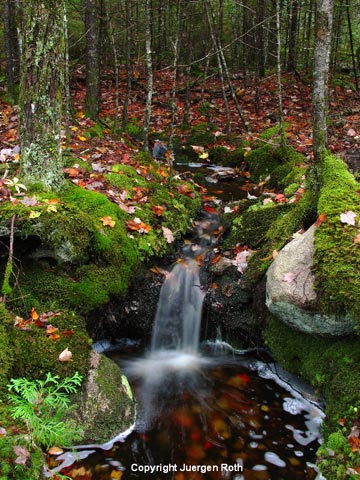
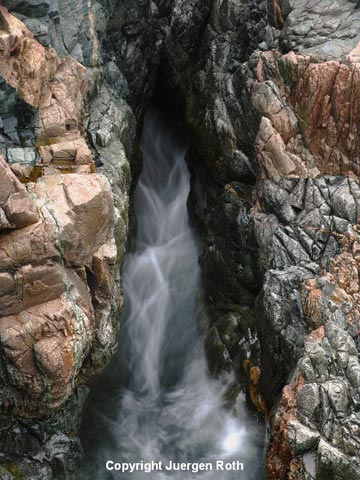
Use A Tripod When photographing Water
For optimal image quality and minimum blurriness of the surrounding landscape during the desired longer exposure times, a tripod is a must.
A polarizer filter not only reduces image brightness and provides longer exposure times, but also eliminates reflections from wet surfaces and increases color saturation. Alternatively or in combination with the polarizing filter a neutral density filter or split neutral density filter can be of great use.
For example, in the seascape photograph of the Maine coastline in Acadia National Park below, I was challenged by difficult lighting conditions due to the bright churning waves and misty ocean spray in contrast to the darker landscape scenery of the rocky granite coastline, cove and trees. I also wanted to create an attractive silky ocean water effect and pattern in the incoming waves.
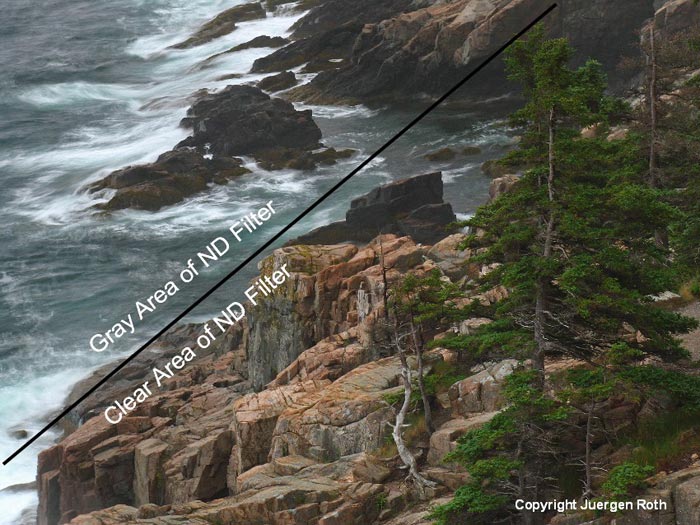
I first metered on the coastline near the ocean’s edge, but that resulted in the rocks, cove and trees being too dark with limited detail in their formations. On the other hand, metering on the large tree provided decent detail in the landscape, but “blew out” the ocean, leaving it washed out. As a solution, I went back to metering on the large tree that provided a correct exposure setting for the coastline’s foreground. This produced a slow enough shutter speed that would be sufficient for the desired silky ocean water effect. I hand-held a 1 stop graduated neutral density filter in front of my lens, placing it near the edge of ocean and shoreline, which reduced the incoming light from the whites of the ocean and dark rocks in the background to an amount that still showed enough detail. This kept the trees, cove and granite coastline in the foreground correctly exposed for the highest possible image impact.
Fall foliage resting on rocks and boulders in streams make for fantastic images as well when photographing water .
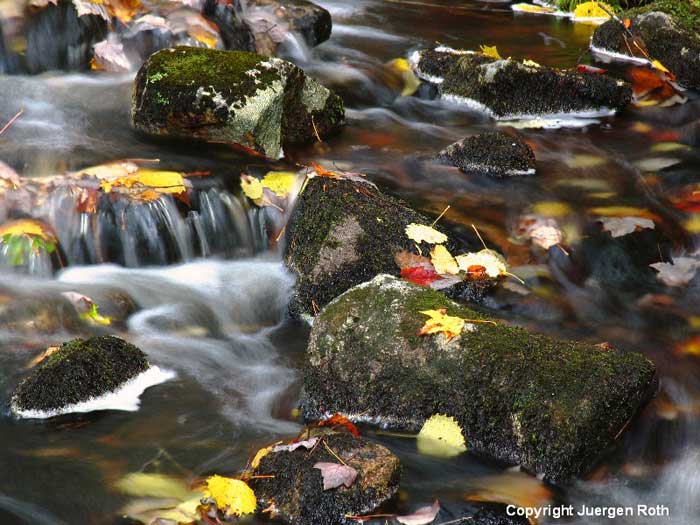
While walking downstream along the Sabbaday Brook in the White Mountains of New Hampshire, I stumbled upon the incredible nature setting below. Call it being in the right place at the right time! I composed the image so that the leaf leads your eye into the photograph and keeps you focused on the subject. In order to do so I had to maneuver my tripod set up on other rocks and partly in the brook itself. While I balanced myself at the edge of the stream, I managed to set up my camera. I shot the image using the self-timer to limit camera shake and picture blurriness. Besides the rock and the leaf, the photograph shows Sabbaday Brook gently flowing in the background. The moving stream provides a perfect backdrop and keeps the viewer’s interest on the main subject and within the photo.
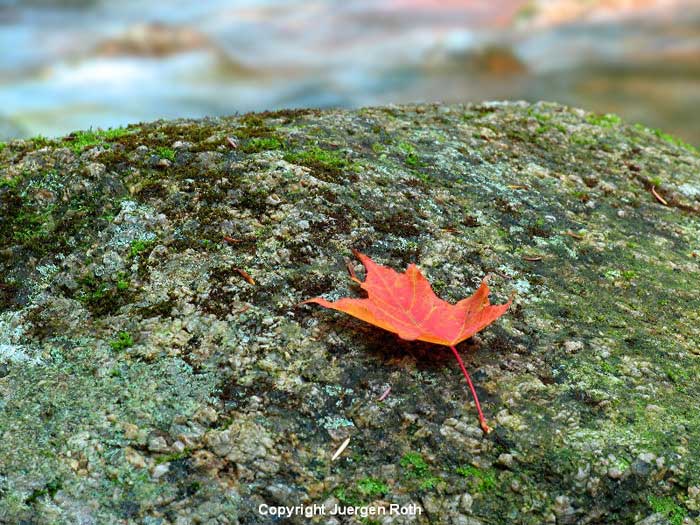
And don’t forget to look for color hanging above the creeks or for the shapes and forms created as the water curves around individual rocks or groups of rocks protruding above the surface of the water. By slowing down your shutter speed you can highlight and soften the flow of the water, giving your image an added touch of artistry.
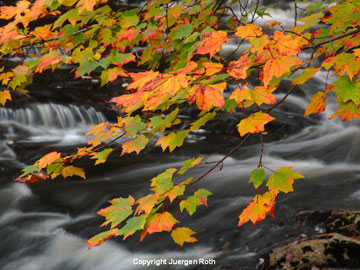
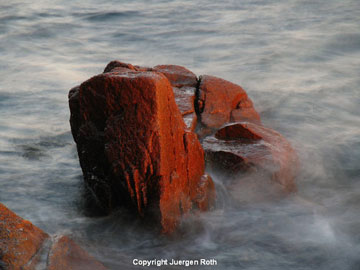
Part II: Brilliant Water Reflections
In this award winning photograph of a Cape Cod dinghy, the sun was already up, partly painting the boat in the glorious morning hour light. I still sometimes get carried away by certain scenes and start shooting following my instincts instead of analyzing the scene. And that’s perfectly fine! After you’ve taken the initial shot or shots, then slow yourself down and begin to really look at your photo subject and its surrounding and you’ll begin to see so much more.
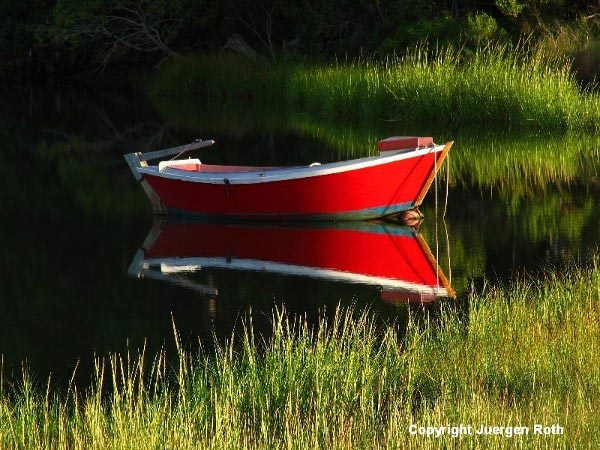
First I captured the boat directly from the parking lot, but then made my way towards the overpass where I kept shooting. I then crossed the bridge and moved closer to the boat incorporating the grass in the front of the composition. At that point I also decided to change my lens range to a 300 mm, zooming in further and achieving a narrower, more intimate view of the dinghy.
It was a very quiet and windless morning which made it a good day to capture water reflections. When photographing water, be patient until there is no wind and calm waters occur. Your best bet for calm waters is during the early morning and late afternoon hours.
I also chose to use a polarizing filter which was carefully adjusted to not negatively impact the water reflection, but instead boost the colors and saturation. The focus point was laid on the real object rather than on the reflection to ensure a razor sharp image. A low ISO setting combined with a small aperture (large f-stop setting) guaranteed maximum detail in the surrounding grass.
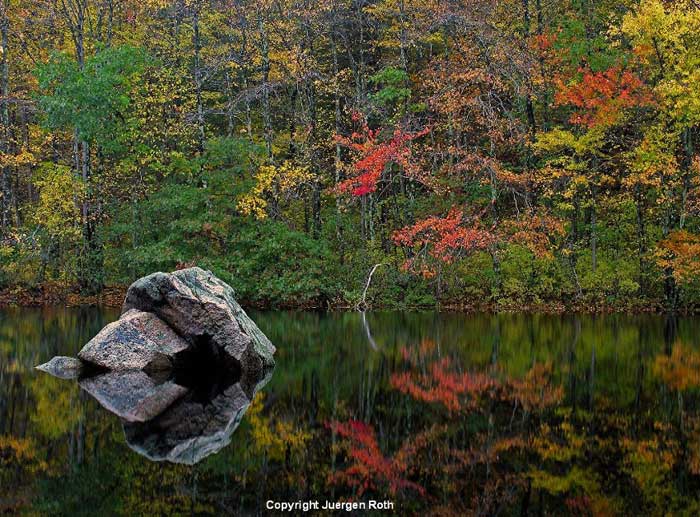
Nature Reflection above is another example where a polarizing filter came in handy. In this case the polarizing filter eliminated glare on the leaves and intensified the reflection.
When taking scenic photos, you’ll also need to determine whether the sky is an asset to the overall image and the subject or a distraction. In this image I choose a mid-range focal length to cut out a boring overcast sky and selected a small aperture (large f-stop setting) for maximum depth of field that focused your attention on the rocks, since this was my primary subject. I then bracketed exposure so I would be ensured a proper image.
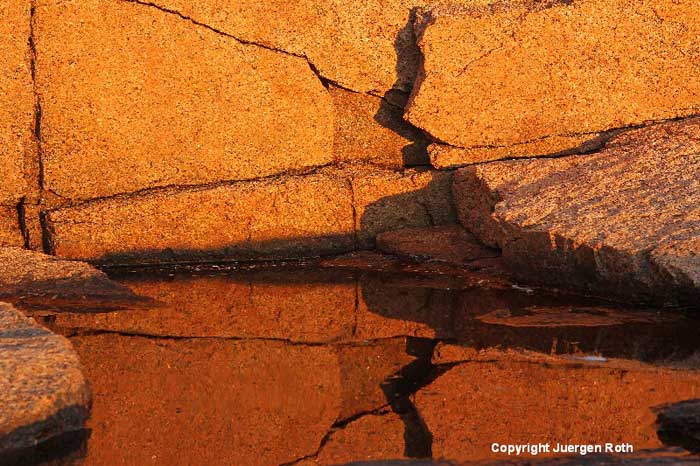
This last photo was taken on Little Hunters Beach in Acadia National Park in Maine. The morning light beautifully lit the granite rock formation and I incorporated its tide pool reflection into the composition, which made for a beautiful abstract image.
Nature will always provide the scene, so it’s up to you to use your ability to “see”, your creativity and camera know-how to produce those stunning images.
by Juergen Roth
All text & photos: © 2012 Juergen Roth. All rights reserved.

Leave a Reply